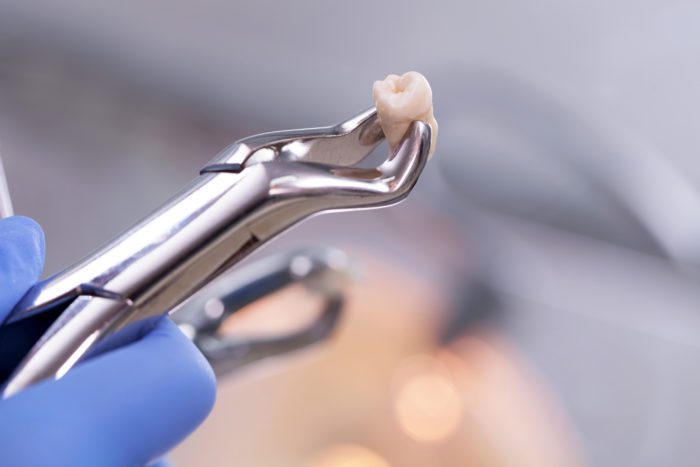Extractions can range from a single tooth to removing all four wisdom teeth at once. Based on the preference of the doctor and/or the patient, a local anesthetic could be used to numb the areas where the teeth will be extracted. Others will prefer to go under a general anesthetic so that they will be sedated during the procedure.
We ensure comfort during tooth extraction treatment in our Galveston, TX, office. Sometimes, we will recommend extractions to prevent the spread of infection or future dental problems.

Wisdom Teeth
Wisdom teeth extractions are a fairly common procedure. Wisdom teeth often cause problems as they are trying to protrude through the gums. When a wisdom tooth is impacted, it means the tooth is coming in at an angle and not straight through the gum line. This can cause pain, the tooth can come in unevenly, or the tooth may only emerge partially.
When a wisdom tooth only emerges partially, a flap of skin, called an operculum, may form over the tooth. This can make the tooth hard to clean, and pieces of food may be caught under the skin. This makes it easy for an infection, called pericoronitis, to develop. It will usually go away independently, but it causes swelling and pain.
Impacted teeth and wisdom teeth that can potentially cause problems, like infections, must be removed.
Tooth Extractions in Galveston, TX
The gum tissue around the wisdom tooth is cut open to reveal the tooth during a wisdom tooth extraction. The tooth is loosened by gripping it tightly and wiggling it back and forth until it can be lifted from the gums. Sometimes a tooth may be impacted so tightly that it cannot be lifted from the gums.
In cases like this, the tooth will be broken up into pieces before removal. Depending on the incision and extraction site, sutures may be needed to close the area. Soluble sutures are the best option, which will dissolve on their own.
Tooth Extractions: Post-Op Instructions
After the surgery, you will need to rest. Because of the anesthesia, you must be driven home by a friend or family member. After the surgery, you can expect the extraction site to bleed for a little while. Gauze will be applied after the surgery, and you must change it when it becomes soaked.
If bleeding continues for longer than 24 hours, you should call your dentist. Rest when you return home but do not lie flat. This could prolong the bleeding. Prop your head up on a pillow when lying down.
Your dentist will prescribe pain medication, so if you become sore, take it as directed. You can also use an ice pack for the pain. Your dentist might also provide a cleaning solution to clean the extraction site.
When drinking, make sure you do not use a straw. The sucking motion can loosen your sutures and slow the clotting process. The same goes for smoking. If you have prolonged pain, bleeding, or irritation or don’t feel the extraction site is healing properly, call your dentist for a follow-up.
You will be limited to soft foods for a few days after surgery. Some recommended foods are:
- Gelatin
- Pudding
- Yogurt
- Mashed Potatoes
- Ice Cream
- Thin Soups
…and other food you can eat without chewing.
When drinking, make sure you do not use a straw. The sucking motion can loosen your sutures and slow the clotting process. The same goes for smoking. Call your dentist for a follow-up if you have prolonged pain, bleeding, or irritation or don’t feel the extraction site is healing properly.
Receive Comfortable Treatment
Contact Broadway Dental for extraction treatment today at 409-235-0789. You may also schedule your next dental visit with us online.
